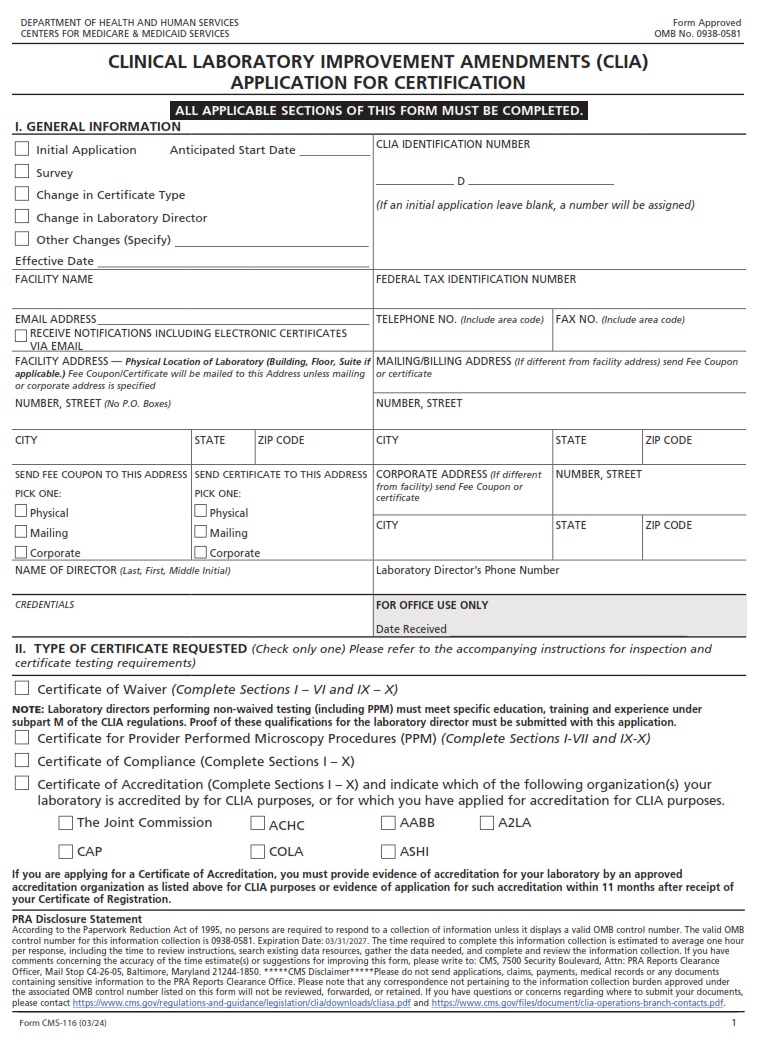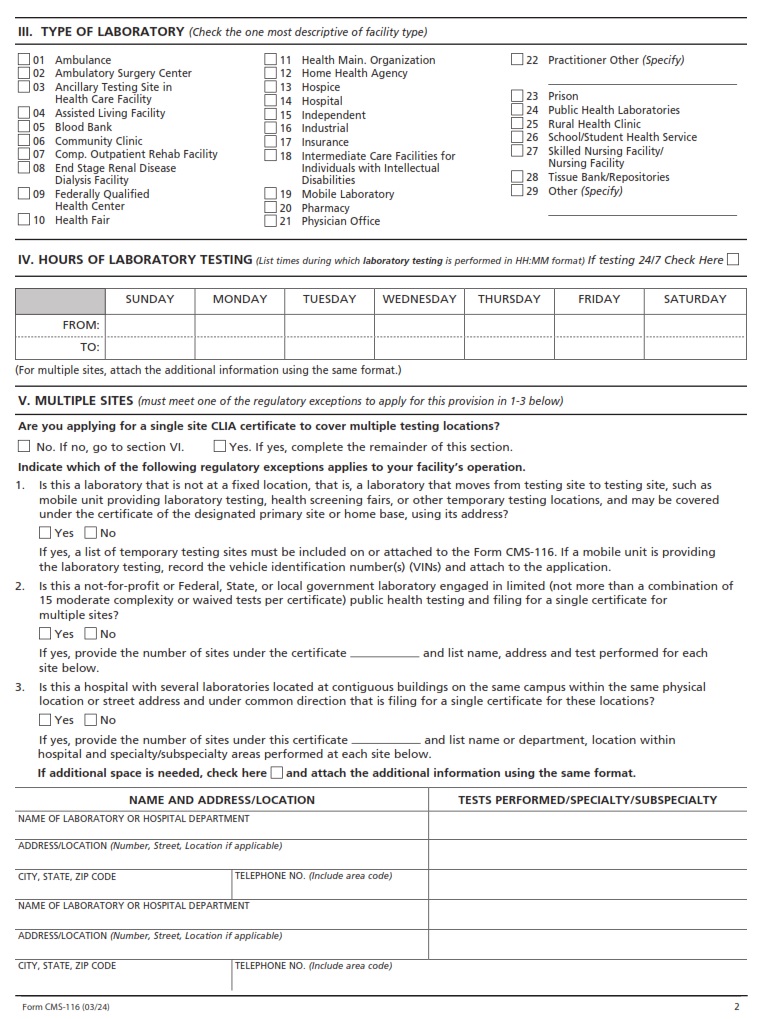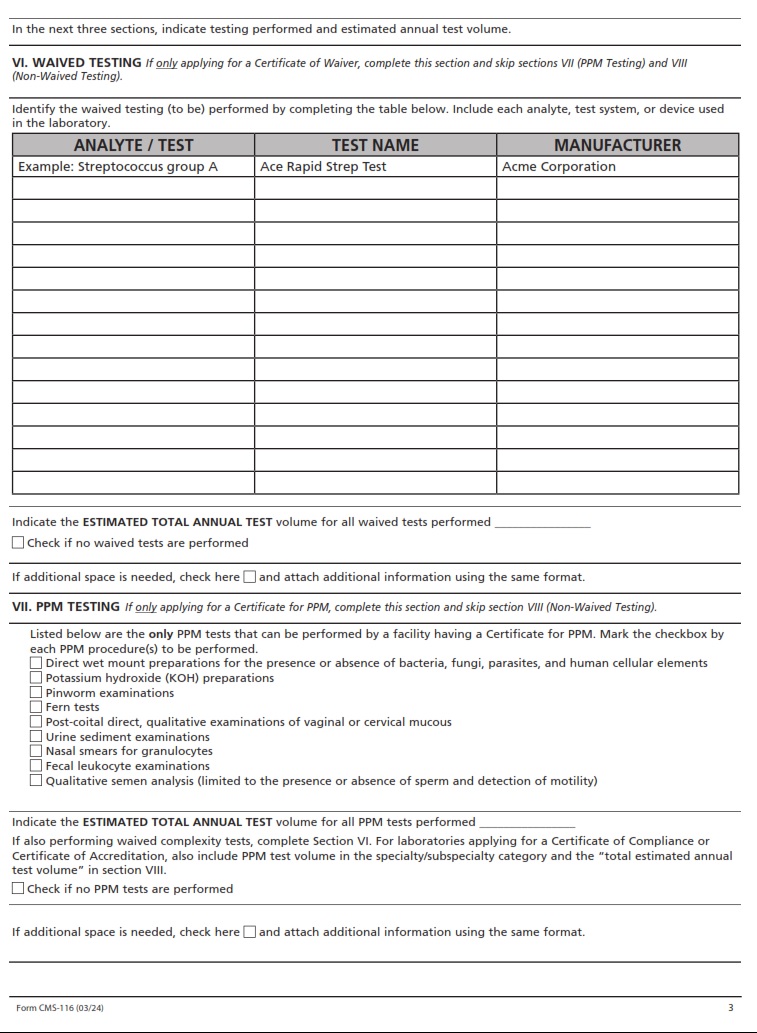CMSFORM.ORG – CMS 116 – CLINICAL LABORATORY IMPROVEMENT AMENDMENTS OF 1988 (CLIA) APPLICATION FOR CERTIFICATION – In the ever-evolving landscape of healthcare, ensuring the accuracy and reliability of clinical laboratory testing is paramount. Enter CMS 116 – the Clinical Laboratory Improvement Amendments (CLIA) of 1988, a pivotal regulatory framework that revolutionized laboratory standards in the United States. This application for certification serves as a beacon of quality assurance, setting forth rigorous guidelines to safeguard patient care and enhance diagnostic precision. Delving into the intricate world of CLIA certification unveils a realm where meticulous protocols intersect with cutting-edge technology, shaping the backbone of modern healthcare practices. Join us on a journey through the labyrinthine corridors of CLIA certification and discover how this transformative legislation continues to shape the future of clinical diagnostics.
Download CMS 116 – CLINICAL LABORATORY IMPROVEMENT AMENDMENTS OF 1988 (CLIA) APPLICATION FOR CERTIFICATION
| Form Number | CMS 116 – |
| Form Title | CLINICAL LABORATORY IMPROVEMENT AMENDMENTS OF 1988 (CLIA) APPLICATION FOR CERTIFICATION |
| Published | 2020-04-01 |
| O.M.B. | 0938-0581 |
| File Size | 445 KB |
What is a CMS 116?
A CMS 116 form, also known as the Clinical Laboratory Improvement Amendments (CLIA) Application for Certification, plays a crucial role in ensuring the quality and reliability of clinical laboratory testing. This form is required for labs seeking certification to conduct testing on human specimens. By completing the CMS 116, laboratories are declaring their compliance with CLIA regulations and committing to maintaining high-quality standards in their testing procedures. It serves as a formal application process through which laboratories demonstrate their proficiency in performing accurate and reliable tests for patient care.
The CMS 116 application encompasses detailed information about the laboratory’s personnel qualifications, quality control procedures, test methods, and overall operational structure. Laboratories must provide evidence of adherence to CLIA requirements such as participating in proficiency testing programs and implementing proper quality assurance measures. This comprehensive documentation process ensures that certified labs meet strict regulatory standards to safeguard patient health and maintain credibility within the healthcare industry. The CMS 116 form signifies a commitment to excellence and accountability in clinical laboratory practices, ultimately benefiting both patients and healthcare providers alike.
Where Can I Find a CMS 116?
When seeking to acquire a CMS 116 form for CLIA certification, several avenues can be explored. One primary source is the Centers for Medicare & Medicaid Services (CMS) website, where the form can typically be downloaded in PDF format. Alternatively, reaching out to your state’s Department of Health or local CLIA program can provide guidance on obtaining the necessary documentation for certification.
For those looking beyond official channels, online platforms offering resources and services for healthcare compliance may also have the CMS 116 form available for download or purchase. It is important to ensure that any version obtained is up-to-date and compliant with current regulations to streamline the application process without setbacks. In navigating the complexities of CLIA certification, tapping into various sources can lead to a smoother journey towards compliance and quality improvement in clinical laboratory practices.
CMS 116 – CLINICAL LABORATORY IMPROVEMENT AMENDMENTS OF 1988 (CLIA) APPLICATION FOR CERTIFICATION
Applying for certification under the Clinical Laboratory Improvement Amendments of 1988 (CLIA) can seem like a daunting task, but it is a crucial step in ensuring the quality and accuracy of laboratory testing. The process involves thorough documentation of quality control procedures, personnel qualifications, and facility standards to demonstrate compliance with CLIA regulations. By successfully navigating the CLIA application process, laboratories can not only meet regulatory requirements but also enhance their credibility and reputation.
One key aspect of the CLIA certification application is demonstrating proficiency in conducting accurate and reliable laboratory tests. This involves implementing standard operating procedures (SOPs), establishing quality controls, and participating in proficiency testing programs to validate the accuracy and reliability of test results. By investing time and resources into ensuring compliance with CLIA requirements, laboratories can build trust among patients, healthcare providers, and regulatory agencies.
In today’s rapidly evolving healthcare landscape, stringent regulations like CLIA play a vital role in safeguarding patient safety and maintaining high standards of care. Laboratories that undergo the certification process demonstrate their commitment to quality assurance and continuous improvement in laboratory practices. Ultimately, obtaining CLIA certification not only signifies regulatory compliance but also signifies a dedication to delivering accurate diagnostic services that contribute to better patient outcomes.


